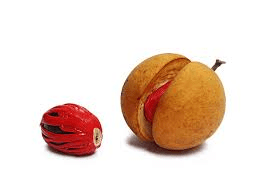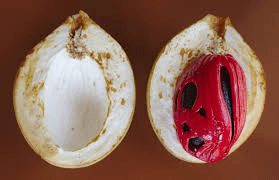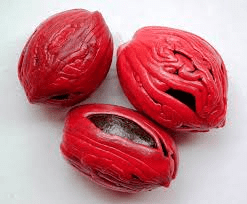The Nutmeg Outer Shell, scientifically known as Myristica fragrans, is a key part of the fruit of the nutmeg tree. This tree is native to the Banda Islands in Indonesia and is also cultivated in other tropical regions worldwide. The outer shell, often referred to as the pericarp or husk, surrounds the seed and plays several important roles in protecting and dispersing the seed.
The pericarp of nutmeg is thick and woody, typically measuring about 2 to 3 millimeters in thickness. Its surface is rough and slightly wrinkled, giving it a textured appearance. The color of the outer shell varies from yellowish-brown to light grey, depending on the maturity of the fruit. When the fruit is young, the shell is green, but it gradually turns yellow as it ripens and dries.
Chemically, the outer shell of nutmeg contains various compounds that contribute to its aroma and flavor. These compounds include terpenes, phenylpropanoids, and fatty acids. The characteristic fragrance of nutmeg is mainly due to the presence of myristicin, a compound found in both the seed and the outer shell. Myristicin is responsible for the warm, spicy aroma that nutmeg is known for.
From a botanical perspective, the outer shell serves as a protective layer for the seed inside. It acts as a barrier against physical damage and helps prevent moisture loss, which is crucial for the survival of the seed. In nature, this protective shell also plays a role in seed dispersal. Once the fruit matures and the outer shell dries, it splits open to reveal the seed. This allows the seed to be easily dispersed by animals or wind, promoting the propagation of the nutmeg tree.
Harvesting nutmeg involves collecting the fruits when they are fully mature but still green. The outer shell is then removed to extract the seed inside, which is the valuable spice known as nutmeg. The extraction process typically involves drying the outer shell and separating it from the seed. The dried shells can be further processed to extract essential oils or used in various culinary and medicinal applications.
In traditional medicine, extracts from the outer shell of nutmeg have been used for their aromatic and medicinal properties. They are believed to have digestive benefits and may help alleviate symptoms such as nausea and indigestion. However, it’s important to note that the outer shell contains myristicin and other compounds in smaller quantities compared to the seed, which is the primary source of nutmeg spice.
The outer shell of nutmeg is a vital component of the fruit, serving both protective and dispersal functions in nature. Its chemical composition contributes to the overall aroma and flavor profile of nutmeg spice, making it a prized ingredient in culinary and medicinal applications worldwide. Understanding the role of the outer shell enhances appreciation for the complexity and versatility of this beloved spice.
The Economic Importance and Uses of Nutmeg Outer Shell

1. Spice Production: The outer shell of nutmeg is used in the production of mace, a valuable spice with culinary and medicinal uses.
2. Culinary Uses: Ground nutmeg shell is used as a spice in cooking and baking, adding flavor to dishes like soups, sauces, and desserts.
3. Herbal Remedies: Nutmeg shell extracts are used in traditional herbal medicine for their medicinal properties, such as aiding digestion and relieving pain.
4. Essential Oil Extraction: The outer shell is processed to extract essential oils used in aromatherapy, perfumery, and skincare products.
5. Natural Dyes: Nutmeg shell extracts are used as natural dyes for textiles and food products, imparting earthy tones.
6. Pharmaceutical Industry: Nutmeg shell extracts are used in pharmaceutical formulations for their therapeutic benefits, including antimicrobial and antioxidant properties.
7. Animal Feed: Residues from nutmeg processing can be used as nutritious additives in animal feed.
8. Organic Fertilizers: Nutmeg shell residues are composted to create organic fertilizers for agriculture.
9. Cosmetics: Nutmeg shell extracts are used in cosmetic formulations for their exfoliating and antioxidant properties.
10. Aromatherapy: Nutmeg shell essential oil is used in aromatherapy to promote relaxation and reduce stress.
11. Flavoring Agents: Nutmeg shell extracts are used as natural flavoring agents in food and beverage products.
12. Textile Industry: Nutmeg shell extracts are used to dye fabrics and yarns, producing natural and sustainable colors.
13. Decorative Items: Nutmeg shells are used in crafts and decorative arts, such as making ornaments and jewelry.
14. Biofuel Production: Nutmeg shell residues can be processed into biofuels, contributing to renewable energy sources.
15. Water Purification: Nutmeg shell charcoal is used in water filtration systems to remove impurities.
16. Antimicrobial Applications: Nutmeg shell extracts have antimicrobial properties used in hygiene products and sanitizers.
17. Soil Amendment: Nutmeg shell residues are used to improve soil structure and nutrient content.
18. Educational Purposes: Nutmeg shells are used in educational settings to teach about spices, agriculture, and environmental sustainability.
Read Also: Hypoallergenic Cat Breeds Description and Complete Care Guide
The Products and By-products That Can Be Derived From Nutmeg Outer Shell

1. Mace Production: The outer shell of nutmeg yields mace, which is used as a spice in culinary applications.
2. Nutmeg Shell Powder: Ground nutmeg shell is used as a spice and flavoring agent in food products.
3. Nutmeg Shell Essential Oil: Steam distillation of nutmeg shell produces essential oils used in aromatherapy and cosmetics.
4. Nutmeg Shell Extracts: Extracts from nutmeg shell are used in pharmaceuticals, herbal remedies, and dietary supplements.
5. Nutmeg Shell Charcoal: Charcoal from nutmeg shell is used as a natural filter in water purification systems.
6. Nutmeg Shell Biofuel: Residues from nutmeg shell can be processed into biofuels for energy production.
7. Nutmeg Shell Infused Oils: Nutmeg shell extracts are infused into carrier oils for skincare and cosmetic products.
8. Nutmeg Shell Dyes: Extracts from nutmeg shell are used as natural dyes for textiles and food coloring.
9. Nutmeg Shell Animal Feed: Residues from nutmeg processing are used as nutritious additives in animal feed.
10. Nutmeg Shell Fertilizer: Composted nutmeg shell residues are used as organic fertilizers for agriculture.
11. Nutmeg Shell Decorations: Nutmeg shells are used in crafts and decorative arts, such as making ornaments and jewelry.
12. Nutmeg Shell Bioactive Compounds: Nutmeg shell extracts contain bioactive compounds used in pharmaceutical and cosmetic formulations.
13. Nutmeg Shell Biodegradable Products: Nutmeg shell residues are used to produce biodegradable plastics and packaging materials.
14. Nutmeg Shell Antioxidants: Extracts from nutmeg shell are rich in antioxidants used in skincare and dietary supplements.
15. Nutmeg Shell Medicinal Uses: Nutmeg shell extracts are used in traditional medicine for their therapeutic properties.
16. Nutmeg Shell Exfoliants: Ground nutmeg shell is used as a natural exfoliant in cosmetic and skincare products.
17. Nutmeg Shell Educational Tools: Nutmeg shells are used in educational settings to demonstrate spice production and environmental sustainability.
Read Also: Orange Cat Breeds Description and Complete Care Guide
Frequently Asked Questions (FAQ’s) About Nutmeg Outer Shell

1. What is nutmeg outer shell?
Nutmeg outer shell refers to the outer covering of the nutmeg fruit, which surrounds the seed and is used to produce mace.
2. How is nutmeg outer shell used in cooking?
Ground nutmeg shell is used as a spice to flavor various dishes, including soups, sauces, and desserts.
3. Can nutmeg outer shell be used for medicinal purposes?
Yes, extracts from nutmeg outer shell are used in traditional herbal medicine for digestive issues and pain relief.
4. How is nutmeg shell essential oil produced?
Nutmeg shell essential oil is produced through steam distillation of the outer shell, yielding aromatic compounds used in aromatherapy and perfumery.
5. What are the benefits of nutmeg outer shell in skincare?
Nutmeg shell extracts have antioxidant and exfoliating properties, making them beneficial in skincare products.
6. Can nutmeg outer shell be used in water purification?
Yes, nutmeg shell charcoal is used in water filtration systems to remove impurities and improve water quality.
7. What products can be made from nutmeg outer shell?
Products such as mace, spices, essential oils, extracts, charcoal, dyes, and biofuels can be derived from nutmeg outer shell.
8. Are there any environmental uses for nutmeg outer shell?
Yes, nutmeg shell residues are composted to produce organic fertilizers and used as biofuels, contributing to environmental sustainability.
9. How is nutmeg outer shell used in aromatherapy?
Nutmeg shell essential oil is used in aromatherapy to promote relaxation, reduce stress, and enhance mood.
10. What educational purposes does nutmeg outer shell serve?
Nutmeg shells are used in educational settings to teach about spice production, agriculture, and sustainable practices.
Read Also: Benefits of Osteospermum
